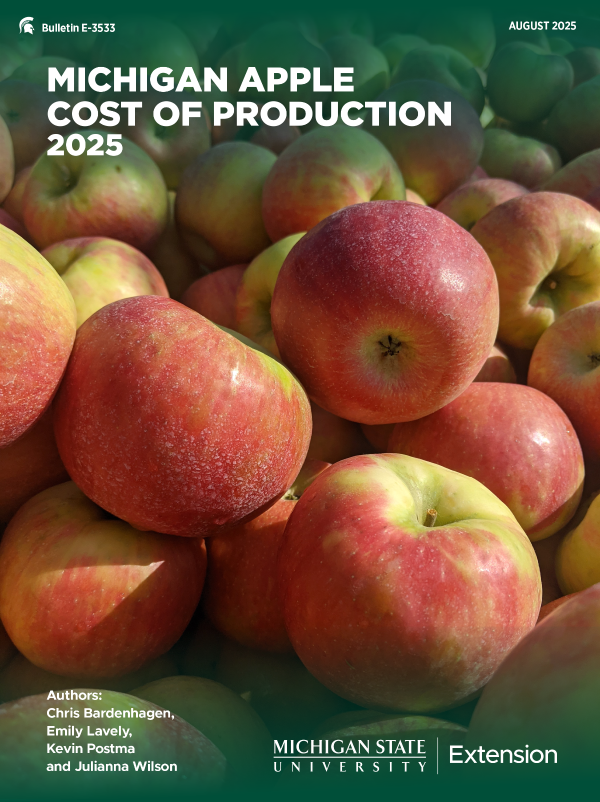
Bulletin E3533
Michigan Apple Cost of Production 2025
DOWNLOAD
September 2, 2025 - Chris Bardenhagen, Emily Lavely, Kevin Postma and Julianna Wilson
Michigan’s bearing apple acreage has increased substantially since 2017. Much of the acreage being planted or replanted today is in high density, trellised orchards, but a substantial amount of acreage continues to be planted into medium density, semidwarf orchards. This study focused on developing enterprise budgets for both high density and semidwarf systems. While we found all plantings to show some level of profitability in current conditions, caution is also warranted. Profitability is very price dependent, and gluts due to overproduction do not need to be large in order to depress prices below the cost of production.
We found that semidwarf systems produce apples at a lower cost per bushel – about 10% to 12% less than high density systems at a given yield. Semidwarf plantings have the advantage of lower tree cost and no trellis system. Less capital is therefore needed for their establishment.
High density systems, however, have the highest profitability overall. This is because their yield potential is substantially higher and production comes on much earlier, leading to more fruit over time. The higher up-front costs of high density establishment (planting costs of $26,578) versus semidwarf establishment (planting costs of $7,676) pay for themselves over time. We found similarly that the extra costs of planting at very high densities, (e.g. 1,800 or 2,000 trees per acre) should be easily covered with a slightly higher yield (2 bins/acre/year) or earlier onset of production.
Our climate analysis found that the high density systems are more carbon friendly than semidwarf systems, due to the higher volumes of fruit produced using similar amounts of carbon. However, both systems were found to be more carbon friendly than row cropping, an alternative land use.
We conducted analysis on three variety types: high-value (Honeycrisp, Tango), midvalue (Gala, Fuji, other fresh), and processing varieties. Operating costs for producing processing apples are about 19% less than fresh. We determined that variable harvest costs, not including trucking, are about $71 per bin for high-value, $45 per bin for midvalue and $35 per bin for processing apples.
For high density systems, the high-value (Honeycrisp) breakeven price, at a yield of 1,000 bu/acre, is $211/bin (price received from packer when dropped at packer’s cooler or dock). At 1,200 bu/acre, the midvalue (Gala, Fuji) break-even dock price is $163/bin. For semidwarf systems, the high-value (Honeycrisp) breakeven price at 700 bu/acre is $235 per bin, and the midvalue (Gala, Fuji) breakeven price at 900 bushels per acre is $175 per bin. Note that these numbers include a $5 allocation for trucking from farm to packer. Note also that the stated yields are considered to be the amount sent to the packer (versus the field yield per acre). Tables showing breakeven numbers for different yields and prices are provided in the main report.



 Print
Print Email
Email


